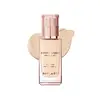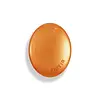What's inside
What's inside
 Key Ingredients
Key Ingredients

 Benefits
Benefits

 Concerns
Concerns

 Ingredients Side-by-side
Ingredients Side-by-side

Water
Skin ConditioningCyclopentasiloxane
EmollientTitanium Dioxide
Cosmetic ColorantTrimethylsiloxysilicate
EmollientButylene Glycol
HumectantIsododecane
EmollientDimethicone
EmollientPentylene Glycol
Skin ConditioningPEG/PPG-18/18 Dimethicone
EmulsifyingPEG-9 Polydimethylsiloxyethyl Dimethicone
EmulsifyingHydrolyzed Collagen
EmollientMagnesium Sulfate
Polyglyceryl-3 Diisostearate
EmulsifyingPolymethylsilsesquioxane
Tridecyl Trimellitate
EmollientTocopheryl Acetate
AntioxidantAluminum Hydroxide
EmollientTribehenin
EmollientDisteardimonium Hectorite
StabilisingPolypropylsilsesquioxane
Stearic Acid
CleansingTriethoxycaprylylsilane
Caprylyl Glycol
EmollientGlyceryl Caprylate
EmollientPropylene Carbonate
SolventPEG-10 Dimethicone
Skin Conditioning1,2-Hexanediol
Skin ConditioningXanthan Gum
EmulsifyingDisodium EDTA
Parfum
MaskingChromium Hydroxide Green
Ferric Chloride
AstringentFerrous Fumarate
Skin ConditioningWater, Cyclopentasiloxane, Titanium Dioxide, Trimethylsiloxysilicate, Butylene Glycol, Isododecane, Dimethicone, Pentylene Glycol, PEG/PPG-18/18 Dimethicone, PEG-9 Polydimethylsiloxyethyl Dimethicone, Hydrolyzed Collagen, Magnesium Sulfate, Polyglyceryl-3 Diisostearate, Polymethylsilsesquioxane, Tridecyl Trimellitate, Tocopheryl Acetate, Aluminum Hydroxide, Tribehenin, Disteardimonium Hectorite, Polypropylsilsesquioxane, Stearic Acid, Triethoxycaprylylsilane, Caprylyl Glycol, Glyceryl Caprylate, Propylene Carbonate, PEG-10 Dimethicone, 1,2-Hexanediol, Xanthan Gum, Disodium EDTA, Parfum, Chromium Hydroxide Green, Ferric Chloride, Ferrous Fumarate
Water
Skin ConditioningCI 77891
Cosmetic ColorantCyclopentasiloxane
EmollientTrimethylsiloxysilicate
EmollientMethyl Trimethicone
Skin ConditioningButylene Glycol
HumectantDimethicone
EmollientAlcohol Denat.
AntimicrobialNiacinamide
SmoothingC18-21 Alkane
SolventStearyl Heptanoate
EmollientCI 77492
Cosmetic ColorantDimethicone/PEG-10/15 Crosspolymer
Lauryl PEG-9 Polydimethylsiloxyethyl Dimethicone
Skin ConditioningSodium Chloride
MaskingAluminum Hydroxide
EmollientPropanediol
SolventCaprylic/Capric Triglyceride
MaskingGlycerin
HumectantStearic Acid
CleansingCI 77491
Cosmetic ColorantTriethoxycaprylylsilane
Polyhydroxystearic Acid
EmulsifyingCaprylyl Glycol
EmollientIsopropyl Titanium Triisostearate
EmollientBis-PEG-15 Dimethicone/Ipdi Copolymer
Glyceryl Caprylate
EmollientParfum
MaskingSaccharomyces/Xylinum/Black Tea Ferment
Skin ConditioningEthylhexylglycerin
Skin ConditioningStearalkonium Hectorite
Gel Forming1,2-Hexanediol
Skin ConditioningPolyglyceryl-3 Polyricinoleate
EmulsifyingEthylhexyl Palmitate
EmollientIsopropyl Myristate
EmollientIsostearic Acid
CleansingLecithin
EmollientPolyglyceryl-3 Diisostearate
EmulsifyingAdenosine
Skin ConditioningTrisodium Ethylenediamine Disuccinate
Acrylates/Dimethicone Copolymer
Skin ConditioningAloe Barbadensis Leaf Extract
EmollientDioscorea Japonica Root Extract
Skin ConditioningLaminaria Japonica Extract
Skin ProtectingUlmus Davidiana Root Extract
Skin ConditioningViola Mandshurica Flower Extract
AntioxidantPEG-2 Soyamine
EmulsifyingDipropylene Glycol
HumectantCI 77499
Cosmetic ColorantSimmondsia Chinensis Seed Oil
EmollientCI 77288
Cosmetic ColorantCI 77007
Cosmetic ColorantSodium Citrate
BufferingPEG-10 Dimethicone
Skin ConditioningCeramide NP
Skin ConditioningCetearyl Alcohol
EmollientCoffea Arabica Seed Extract
MaskingEucalyptus Globulus Leaf Extract
PerfumingLaurus Nobilis Leaf Extract
MaskingSilica
AbrasiveTheobroma Cacao Seed Extract
AntioxidantVinyl Dimethicone/Methicone Silsesquioxane Crosspolymer
Tocopherol
AntioxidantCholesterol
EmollientCI 77004
Cosmetic ColorantLactobacillus Ferment
Skin ConditioningAscorbic Acid
AntioxidantBiotin
AntiseborrhoeicCarnitine Hcl
HumectantFolic Acid
Skin ConditioningNiacin
SmoothingPantothenic Acid
Skin ConditioningRetinyl Palmitate
Skin ConditioningRiboflavin
Cosmetic ColorantThiamine Hcl
MaskingWater, CI 77891, Cyclopentasiloxane, Trimethylsiloxysilicate, Methyl Trimethicone, Butylene Glycol, Dimethicone, Alcohol Denat., Niacinamide, C18-21 Alkane, Stearyl Heptanoate, CI 77492, Dimethicone/PEG-10/15 Crosspolymer, Lauryl PEG-9 Polydimethylsiloxyethyl Dimethicone, Sodium Chloride, Aluminum Hydroxide, Propanediol, Caprylic/Capric Triglyceride, Glycerin, Stearic Acid, CI 77491, Triethoxycaprylylsilane, Polyhydroxystearic Acid, Caprylyl Glycol, Isopropyl Titanium Triisostearate, Bis-PEG-15 Dimethicone/Ipdi Copolymer, Glyceryl Caprylate, Parfum, Saccharomyces/Xylinum/Black Tea Ferment, Ethylhexylglycerin, Stearalkonium Hectorite, 1,2-Hexanediol, Polyglyceryl-3 Polyricinoleate, Ethylhexyl Palmitate, Isopropyl Myristate, Isostearic Acid, Lecithin, Polyglyceryl-3 Diisostearate, Adenosine, Trisodium Ethylenediamine Disuccinate, Acrylates/Dimethicone Copolymer, Aloe Barbadensis Leaf Extract, Dioscorea Japonica Root Extract, Laminaria Japonica Extract, Ulmus Davidiana Root Extract, Viola Mandshurica Flower Extract, PEG-2 Soyamine, Dipropylene Glycol, CI 77499, Simmondsia Chinensis Seed Oil, CI 77288, CI 77007, Sodium Citrate, PEG-10 Dimethicone, Ceramide NP, Cetearyl Alcohol, Coffea Arabica Seed Extract, Eucalyptus Globulus Leaf Extract, Laurus Nobilis Leaf Extract, Silica, Theobroma Cacao Seed Extract, Vinyl Dimethicone/Methicone Silsesquioxane Crosspolymer, Tocopherol, Cholesterol, CI 77004, Lactobacillus Ferment, Ascorbic Acid, Biotin, Carnitine Hcl, Folic Acid, Niacin, Pantothenic Acid, Retinyl Palmitate, Riboflavin, Thiamine Hcl
Ingredients Explained
These ingredients are found in both products.
Ingredients higher up in an ingredient list are typically present in a larger amount.
1,2-Hexanediol is a synthetic liquid and another multi-functional powerhouse.
It is a:
- Humectant, drawing moisture into the skin
- Emollient, helping to soften skin
- Solvent, dispersing and stabilizing formulas
- Preservative booster, enhancing the antimicrobial activity of other preservatives
Aluminum Hydroxide is a form of aluminum. It can be naturally found in nature as the mineral gibbsite. In cosmetics, Aluminum Hydroxide is used as a colorant, pH adjuster, and absorbent.
As a colorant, Aluminum Hydroxide may add opacity, or reduce the transparency. Aluminum hydroxide is contains both basic and acidic properties.
According to manufacturers, this ingredient is an emollient and humectant. This means it helps hydrate the skin.
In medicine, this ingredient is used to help relieve heartburn and help heal ulcers.
There is currently no credible scientific evidence linking aluminum hydroxide in cosmetics to increased cancer risk.
Major health organizations allow the use of aluminum hydroxide in personal care products and have not flagged it as a carcinogenic risk at typical usage levels.
Learn more about Aluminum HydroxideButylene Glycol (or BG) is used within cosmetic products for a few different reasons:
Overall, Butylene Glycol is a safe and well-rounded ingredient that works well with other ingredients.
Though this ingredient works well with most skin types, some people with sensitive skin may experience a reaction such as allergic rashes, closed comedones, or itchiness.
Learn more about Butylene GlycolCaprylyl Glycol is a humectant and emollient, meaning it attracts and preserves moisture.
It is a common ingredient in many products, especially those designed to hydrate skin. The primary benefits are retaining moisture, skin softening, and promoting a healthy skin barrier.
Though Caprylyl Glycol is an alcohol derived from fatty acids, it is not the kind that can dry out skin.
This ingredient is also used as a preservative to extend the life of products. It has slight antimicrobial properties.
Learn more about Caprylyl GlycolCyclopentasiloxane, or D5, is a silicone used to improve texture of products and trap moisture.
D5 is considered lightweight and volatile. Volatile means it evaporates quickly after application. Once evaporated, D5 leaves a thin barrier that helps keep skin hydrated.
It is also an emollient. Emollients help soften the skin and prevent water loss. Silicones create a silky texture in products. D5 helps other ingredients become more spreadable.
Studies show D5 is safe to use in skincare products. We recommend speaking with a skincare professional if you have concerns.
Learn more about CyclopentasiloxaneDimethicone is a type of synthetic silicone created from natural materials such as quartz.
What it does:
Dimethicone comes in different viscosities:
Depending on the viscosity, dimethicone has different properties.
Ingredients lists don't always show which type is used, so we recommend reaching out to the brand if you have questions about the viscosity.
This ingredient is unlikely to cause irritation because it does not get absorbed into skin. However, people with silicone allergies should be careful about using this ingredient.
Note: Dimethicone may contribute to pilling. This is because it is not oil or water soluble, so pilling may occur when layered with products. When mixed with heavy oils in a formula, the outcome is also quite greasy.
Learn more about DimethiconeGlyceryl Caprylate comes from glycerin and caprylic acid, a fatty acid from coconut. It has emollient and emulsifier properties.
As an emollient, it helps hydrate your skin. Emollients work by creating a barrier on your skin to trap moisture in, helping to keep your skin soft and smooth.
On the other hand, emulsifiers prevent ingredients (such as oil and water) from separating.
Learn more about Glyceryl CaprylateParfum is a catch-all term for an ingredient or more that is used to give a scent to products.
Also called "fragrance", this ingredient can be a blend of hundreds of chemicals or plant oils. This means every product with "fragrance" or "parfum" in the ingredients list is a different mixture.
For instance, Habanolide is a proprietary trade name for a specific aroma chemical. When used as a fragrance ingredient in cosmetics, most aroma chemicals fall under the broad labeling category of “FRAGRANCE” or “PARFUM” according to EU and US regulations.
The term 'parfum' or 'fragrance' is not regulated in many countries. In many cases, it is up to the brand to define this term.
For instance, many brands choose to label themselves as "fragrance-free" because they are not using synthetic fragrances. However, their products may still contain ingredients such as essential oils that are considered a fragrance by INCI standards.
One example is Calendula flower extract. Calendula is an essential oil that still imparts a scent or 'fragrance'.
Depending on the blend, the ingredients in the mixture can cause allergies and sensitivities on the skin. Some ingredients that are known EU allergens include linalool and citronellol.
Parfum can also be used to mask or cover an unpleasant scent.
The bottom line is: not all fragrances/parfum/ingredients are created equally. If you are worried about fragrances, we recommend taking a closer look at an ingredient. And of course, we always recommend speaking with a professional.
Learn more about ParfumPeg-10 Dimethicone is silicone with conditioner and emulsifier properties. It mostly acts as an emollient in skincare and and humectant in haircare.
According to the manufacturer, acidic formulations decrease the stability of this ingredient. It works best in neutral or near neutral formulations.
Polyglyceryl-3 Diisostearate is an emulsifer and emollient. It comes from Isostearic Acid and Polyglycerin-3.
As an emulsifier, it helps stabilize products by preventing oils and water from separating.
This ingredient may not be Malassezia folliculitis, or fungal acne safe.
Learn more about Polyglyceryl-3 DiisostearateStearic Acid is a fatty acid. It is an emollient, emulsifier, and texture enhancer.
As an emollient, stearic acid helps soften skin. It aids the skin's protective barrier by preventing water loss. It also provides a gentle cleansing effect without stripping away natural oils.
Stearic acid may also be used to enhance the texture of products. It can add volume and stabilize ingredients such as water and oil. This can help water and oil ingredients from separating.
Sources of stearic acid include animal or vegetable fats/oils such as coconut or shea. It can be naturally found in butter, cocoa butter, shea butter, vegetable fats, and animal tallow.
This ingredient may not be Malassezia folliculitis, or fungal-acne safe.
Learn more about Stearic AcidTriethoxycaprylylsilane is a silicone used to bind and stabilize ingredients.
As an emulsifier, it helps prevent ingredients from separating. This can help elongate the shelf life of products.
Triethoxycaprylylsilane is often used to coat mineral sunscreens ingredients to help give a better feel. It also helps reduce oxidative stress in sunscreens.
Learn more about TriethoxycaprylylsilaneThis silicone is an emollient. Emollients create a thin film on the skin to prevent moisture from escaping.
It is not soluble in water and helps increase water-resistance in products.
According to a manufacturer, it can blend seamlessly with silicone oils, such as Cyclopentasiloxane.
Learn more about TrimethylsiloxysilicateWater. It's the most common cosmetic ingredient of all. You'll usually see it at the top of ingredient lists, meaning that it makes up the largest part of the product.
So why is it so popular? Water most often acts as a solvent - this means that it helps dissolve other ingredients into the formulation.
You'll also recognize water as that liquid we all need to stay alive. If you see this, drink a glass of water. Stay hydrated!
Learn more about Water